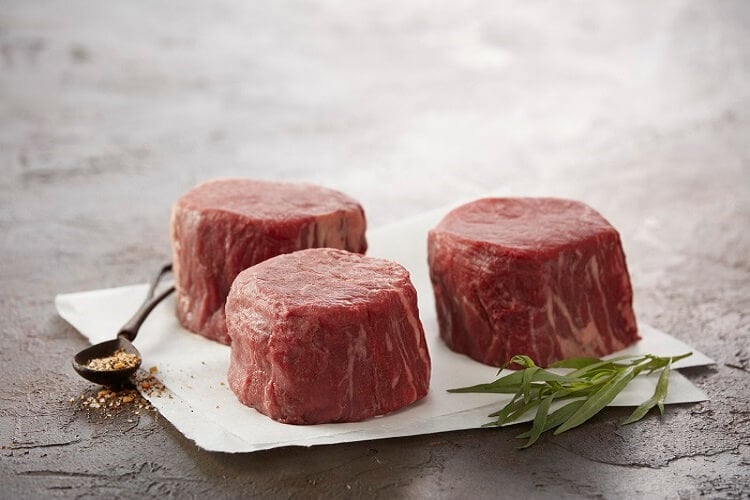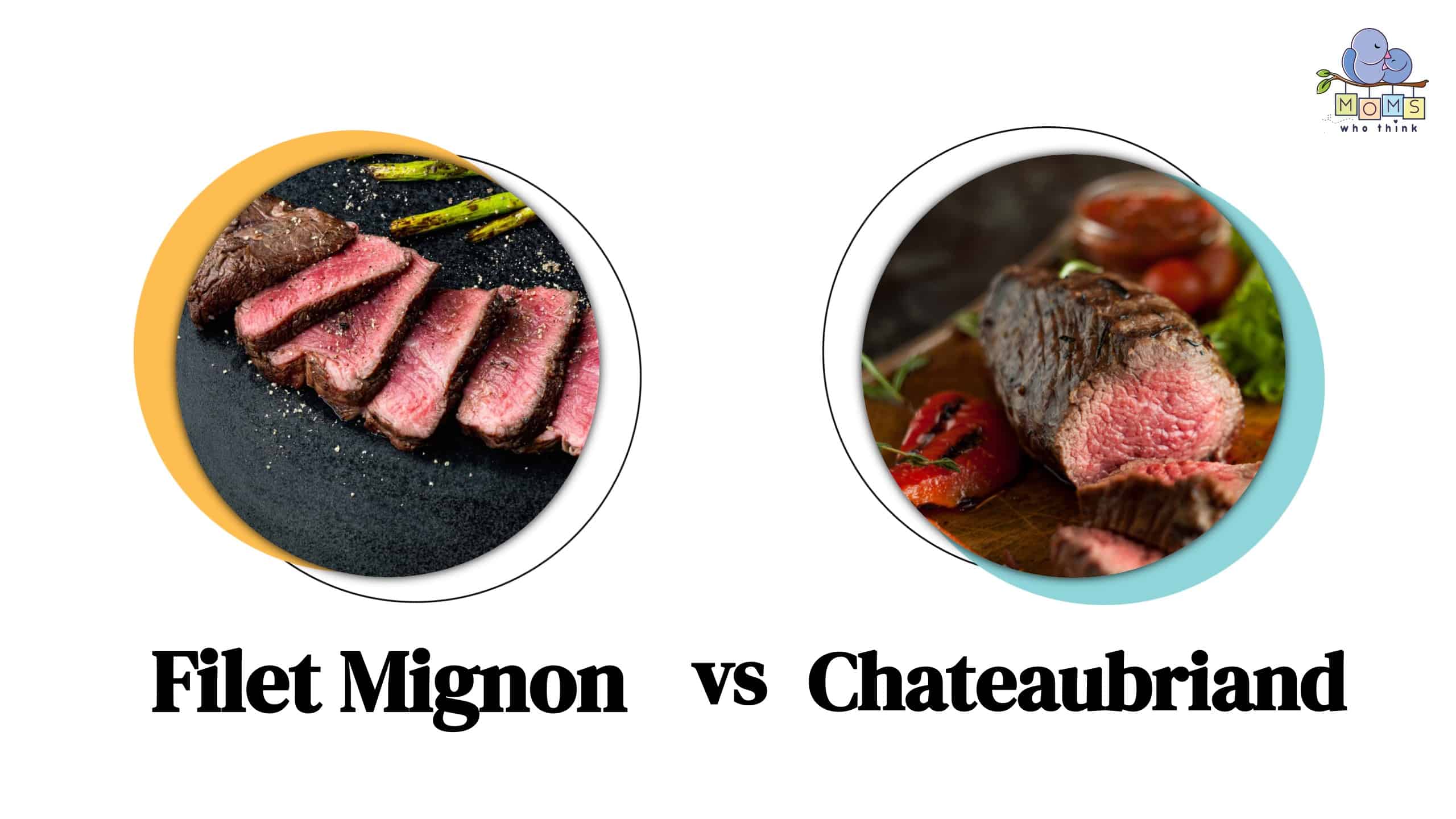Beef Tenderloin Vs Filet Mignon: An Introduction

Beef Tenderloin and Filet Mignon are two popular cuts of beef that are often confused, but they have distinct differences. Beef Tenderloin is a larger primal cut that is located along the spine of the cow. It is known for its tenderness and mild flavor. On the other hand, Filet Mignon refers specifically to a small portion of the Beef Tenderloin that is cut into individual steaks. It is highly prized for its luxurious texture and buttery flavor. Understanding the characteristics and cooking techniques of each cut can help you make the right choice for your next meal.
Beef Tenderloin And Filet Mignon: Definition And Cuts
Beef Tenderloin and Filet Mignon are two distinct cuts of beef. The Beef Tenderloin is a large primal cut that runs along the spine of the cow. It is long and cylindrical in shape. Filet Mignon, on the other hand, refers to the individual steaks that are cut from the Beef Tenderloin. These steaks are small, usually about 1-2 inches thick, and are known for their tenderness and buttery flavor. It is important to note that not all steaks from the Beef Tenderloin are considered Filet Mignon. Only the smaller, more desirable cuts are given this name.
Differences In Beef Tenderloin And Filet Mignon Naming
The naming of Beef Tenderloin and Filet Mignon can cause some confusion. While they come from the same cut of meat, they are not used interchangeably. Beef Tenderloin refers to the entire large primal cut that runs along the spine of the cow. It can be further divided into various steak cuts or used to create a tenderloin roast. On the other hand, Filet Mignon specifically refers to the individual steaks that are cut from the end portion of the Beef Tenderloin. These steaks are highly regarded for their tenderness and flavor.
Beef Tenderloin

Beef Tenderloin is a large primal cut that runs along the spine of the cow. It is highly regarded for its tenderness and flavor. This cut is known for its extremely lean and fine-textured meat. Beef tenderloin is versatile and can be used to create various steak cuts, such as filet mignon, or a delicious tenderloin roast. It is often considered a premium cut of beef and is popular for special occasions and fine dining. Whether grilled, roasted, or pan-seared, beef tenderloin delivers a melt-in-your-mouth experience that is sure to impress.
Beef Tenderloin: Characteristics And Flavor Profile
Beef tenderloin is known for its exceptional tenderness and fine-textured meat. It is a highly sought-after cut due to its lean and flavorful qualities. The meat of beef tenderloin has a smooth and melt-in-your-mouth texture, making it a favorite among steak connoisseurs. Its flavor is delicate and buttery, with subtle hints of sweetness. This makes beef tenderloin perfect for those who prefer a milder taste. Its tenderness and delicate flavor make it a versatile cut that can be prepared using various cooking techniques to suit individual preferences.
Cooking Techniques For Beef Tenderloin
When it comes to cooking beef tenderloin, there are several techniques you can use to bring out its amazing flavor and tender texture. Here are some popular methods:
- Roasting: Roasting beef tenderloin in the oven is a classic and elegant way to prepare this cut. Start by searing it on the stovetop to create a crust, then transfer it to the oven to finish cooking. This method ensures even cooking and a juicy interior.
- Grilling: Grilling beef tenderloin adds a smoky and charred flavor to the meat. Preheat the grill to medium-high heat and sear the tenderloin on all sides before moving it to indirect heat for gentle cooking. Use a meat thermometer to ensure it reaches your desired level of doneness.
- Sous Vide: Sous vide cooking involves sealing the beef tenderloin in a vacuum-sealed bag and cooking it in a water bath at a precise temperature for an extended period. This method guarantees tender and evenly cooked meat, but it requires special equipment.
- Stir-Frying: For a quick and flavorful meal, slice the beef tenderloin into thin strips and stir-fry it with your choice of vegetables and seasonings. This technique allows for a shorter cooking time while maintaining the tenderness of the meat.
- Pan-Searing: Pan-searing is a simple and versatile method for cooking beef tenderloin. Heat a skillet with oil or butter and cook the tenderloin on high heat, turning it occasionally until it reaches your preferred level of doneness.
Remember to let the cooked beef tenderloin rest for a few minutes before slicing or serving to allow the juices to redistribute, resulting in a more tender and flavorful meal. Experimenting with different cooking techniques can help you find your favorite way to prepare this delicious cut of beef.
Filet Mignon

Filet Mignon is known for its exceptional tenderness and melt-in-your-mouth texture. It is derived from the beef tenderloin, specifically the smaller end of the muscle. Filet Mignon is renowned for having a delicate and buttery flavor, making it one of the most expensive and sought-after cuts of beef. Due to its tenderness, Filet Mignon is often cooked using dry heat methods such as grilling, pan-searing, or broiling. Its small size makes it ideal for individual portions or elegant dishes. Whether served on its own or alongside accompaniments, Filet Mignon is a luxurious and indulgent culinary experience.
Filet Mignon: Characteristics And Texture
Filet Mignon is renowned for its exceptional tenderness and melt-in-your-mouth texture. It is derived from the beef tenderloin, specifically the smaller end of the muscle. The Filet Mignon has a delicate and buttery flavor, making it one of the most sought-after cuts of beef. Its texture is incredibly tender, almost velvety, with a fine-grained consistency. The Filet Mignon is known for its lack of marbling, which contributes to its tenderness and smooth texture. When cooked properly, this cut of beef offers a luxurious and enjoyable dining experience.
Best Ways To Cook Filet Mignon
To bring out the best flavors and textures of filet mignon, there are a few cooking methods that work exceptionally well. Here are the best ways to cook filet mignon:
- Searing: Start by searing the filet mignon on high heat to develop a nice crust. Then, finish it off in the oven to ensure even cooking.
- Grilling: Grilling filet mignon gives it a smoky flavor and beautiful grill marks. Cook it over high heat for a few minutes on each side to achieve a perfect medium-rare.
- Pan-roasting: This method combines both searing and oven cooking. Start by searing the filet mignon on the stove, and then transfer it to the oven to finish cooking to your desired level of doneness.
Remember to let the filet mignon rest before slicing into it to allow the juices to redistribute and ensure a tender and flavorful steak.
Nutritional Comparison

Beef Tenderloin vs Filet Mignon
When it comes to the nutritional aspect, beef tenderloin and filet mignon offer similar profiles. Both cuts are lean and provide a good source of protein. A 3-ounce serving of either beef tenderloin or filet mignon contains around 22 grams of protein. However, filet mignon tends to be slightly higher in fat content compared to beef tenderloin. It’s important to note that the fat in filet mignon is mostly monounsaturated, which is considered heart-healthy. Overall, both cuts provide essential nutrients like iron, zinc, and vitamin B12, making them nutritious options for a balanced diet.
Nutritional Value Of Beef Tenderloin Vs Filet Mignon
When it comes to nutritional value, both beef tenderloin and filet mignon offer similar profiles. A 3-ounce serving of either cut contains approximately 22 grams of protein, making them excellent sources of this essential nutrient. However, filet mignon tends to have slightly higher fat content compared to beef tenderloin. It is worth mentioning that the fat in filet mignon is primarily monounsaturated, which is considered heart-healthy. Additionally, both cuts provide important nutrients like iron, zinc, and vitamin B12, making them nutritious options to incorporate into a balanced diet.
Health Benefits And Considerations
Beef tenderloin and filet mignon offer several health benefits and considerations. Both cuts are excellent sources of protein, which is essential for muscle growth and repair. They also provide important nutrients like iron, zinc, and vitamin B12. However, it is crucial to be mindful of the fat content in filet mignon, as it can be higher compared to beef tenderloin. Moderation is key when consuming these cuts, especially for individuals watching their fat intake. Additionally, it is important to choose high-quality, lean cuts and practice proper cooking techniques to maximize the health benefits of these meats.
Taste And Texture

Taste and texture play important roles when comparing beef tenderloin and filet mignon.
Taste Comparison
Both beef tenderloin and filet mignon have a rich and delicate flavor. However, filet mignon is often regarded as the more tender and succulent option because it is cut from the tenderloin’s center. The meat has a buttery texture and melts in your mouth, providing an indulgent dining experience.
Texture Differences and Preferences
Beef tenderloin has a slightly firmer texture compared to filet mignon. Some people prefer the tender and melt-in-your-mouth experience of filet mignon, while others enjoy the slightly firmer texture of beef tenderloin. It ultimately comes down to personal preference and the specific dish you are preparing.
When it comes to taste and texture, both beef tenderloin and filet mignon offer a premium dining experience that satisfies meat lovers’ palates.
Taste Comparison Between Beef Tenderloin And Filet Mignon
Beef tenderloin and filet mignon both offer a rich and delicate flavor that satisfies meat lovers’ palates. However, filet mignon is often regarded as the more tender and succulent option due to its cut from the tenderloin’s center. The meat boasts a buttery texture and melts in your mouth, providing an indulgent dining experience. On the other hand, beef tenderloin has a slightly firmer texture. The choice between the two ultimately comes down to personal preference and the specific dish being prepared. Both cuts guarantee a premium dining experience.
Texture Differences And Preferences
When it comes to texture, there are some notable differences between beef tenderloin and filet mignon. Beef tenderloin has a slightly firmer texture due to its larger size and structure. On the other hand, filet mignon, being a smaller cut from the center of the tenderloin, is incredibly tender and has a buttery texture that melts in your mouth.
Preferences for texture vary among individuals. Some prefer the firmness and bite of beef tenderloin, while others enjoy the melt-in-your-mouth tenderness of filet mignon. It ultimately comes down to personal preference and the specific dish being prepared.
Conclusion

In conclusion, when it comes to the comparison between beef tenderloin and filet mignon, it is evident that both cuts have their own distinct qualities and characteristics. Beef tenderloin offers a larger size and a slightly firmer texture, while filet mignon stands out for its unparalleled tenderness and buttery texture. It ultimately comes down to personal preference and the specific dish being prepared. Whether you prefer a firmer bite or a melt-in-your-mouth experience, both cuts provide a delicious and satisfying dining experience for beef lovers. So, choose the cut that best suits your culinary needs and enjoy the flavors of these remarkable beef cuts.
Key Points On Beef Tenderloin Vs Filet Mignon
When comparing beef tenderloin and filet mignon, it is important to remember the following key points:
- Beef tenderloin refers to the entire long and cylindrical muscle, while filet mignon specifically refers to the smaller portion at the end of the tenderloin.
- Beef tenderloin is larger in size and has a slightly firmer texture, making it a versatile choice for various recipes and cooking methods.
- Filet mignon, on the other hand, is renowned for its unmatched tenderness and buttery texture, making it one of the most prized and sought-after cuts of beef.
- Both cuts offer exceptional flavor and are considered premium cuts of beef, but the choice ultimately depends on personal preference and the desired dining experience.
- When it comes to nutritional value, both cuts are lean and provide a good source of protein, iron, and essential vitamins and minerals.
In summary, whether you prefer the larger size and versatility of beef tenderloin or the tender and luxurious experience of filet mignon, both cuts offer a delicious and satisfying option for beef lovers to enjoy.
Choosing The Right Cut For Your Culinary Needs
When it comes to choosing the right cut for your culinary needs, it ultimately depends on your personal preferences and the specific dish you plan to prepare. Consider the following factors:
- Flavor: If you prefer a more delicate and mild flavor, filet mignon is an excellent choice. However, if you enjoy a slightly richer and beefier taste, beef tenderloin might be more suitable.
- Texture: If you desire a melt-in-your-mouth tenderness, filet mignon is the go-to option. On the other hand, if you prefer a slightly firmer texture that holds up well in different cooking methods, beef tenderloin is the way to go.
- Cooking Techniques: Filet mignon is best suited for quick cooking methods like grilling or pan-searing, as it is already tender. Beef tenderloin, on the other hand, can be used in various recipes, including roasting, grilling, or even using it to make beef Wellington.
- Portion Size: If you’re serving a larger group or want leftovers, beef tenderloin is a better choice due to its larger size. Filet mignon is perfect for smaller, individual portions.
- Budget: While both cuts are considered premium and are more expensive, filet mignon tends to be pricier due to its tenderness and popularity.
Whether you choose beef tenderloin or filet mignon, both cuts are sure to impress with their exceptional flavor and quality. It all comes down to personal preference and the specific dining experience you desire.
FAQ About Beef Tenderloin Vs Filet Mignon: Contrasting Beef Cuts
Q: What is the main difference between beef tenderloin and filet mignon?
A: The main difference is that beef tenderloin refers to the entire cut of meat from the loin area of the cow, while filet mignon specifically refers to the smaller, more tender portion cut from the beef tenderloin.
Q: Which cut is more tender, beef tenderloin, or filet mignon?
A: Filet mignon is generally considered more tender than the rest of the beef tenderloin due to its location in a less worked muscle area of the cow.
Q: In terms of flavor, how do beef tenderloin and filet mignon compare?
A: Both beef tenderloin and filet mignon are known for their mild flavor and lean texture. However, some may argue that filet mignon has a slightly more intense beef flavor compared to other parts of the beef tenderloin.
Q: How should beef tenderloin and filet mignon be cooked to maximize their taste?
A: Both cuts are best cooked using dry heat methods like grilling, roasting, or pan-searing. It’s crucial not to overcook them to retain their tenderness and juicy texture.
Q: Are beef tenderloin and filet mignon suitable for different types of dishes?
A: While both cuts are often served as whole roasts or steak cuts, filet mignon is commonly used for individual servings due to its size and tenderness, making it a popular choice for upscale dishes and steakhouses.
Q: What are some popular dishes that feature beef tenderloin or filet mignon?
A: Beef Wellington, Chateaubriand, and classic steakhouse filet mignon are some popular dishes that showcase the tenderness and flavor of beef tenderloin or filet mignon.

We are introducing OH! NANA, where culinary excellence meets sustainability! Our journey began with a passion for creating delicious, nutrient-dense dishes while minimizing waste and environmental impact. At OH! NANA, we believe that great taste and nutritional value can go hand in hand with responsible sourcing and production. Our commitment to delivering intense flavors and high nutritional value is paired with a dedication to reducing waste in every aspect of our operations. From sourcing fresh, locally-grown ingredients to implementing efficient kitchen practices, we strive to positively impact both your health and the health of our planet.